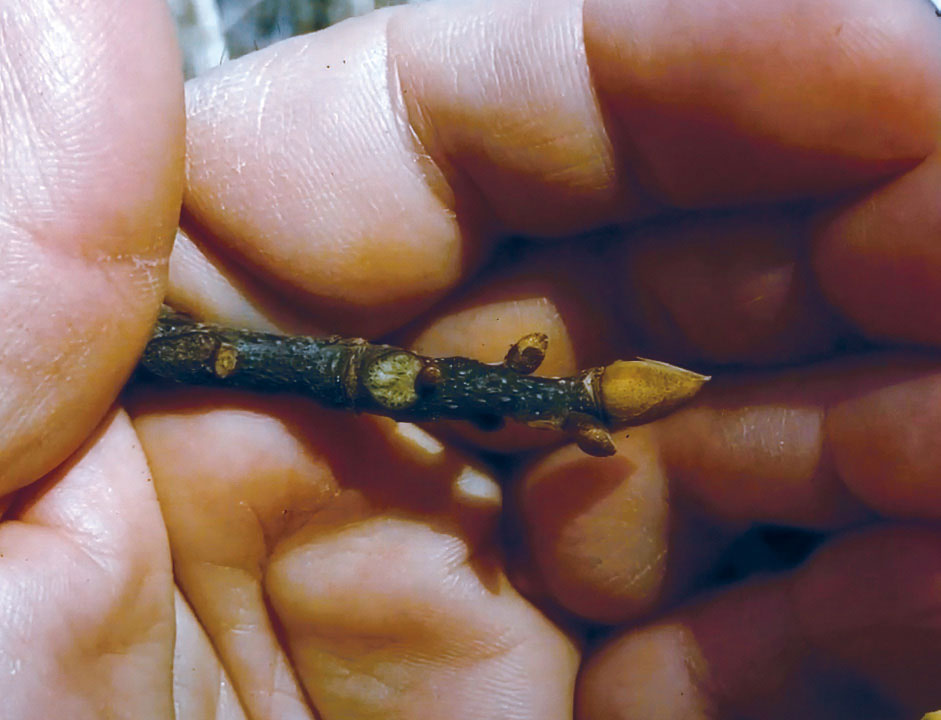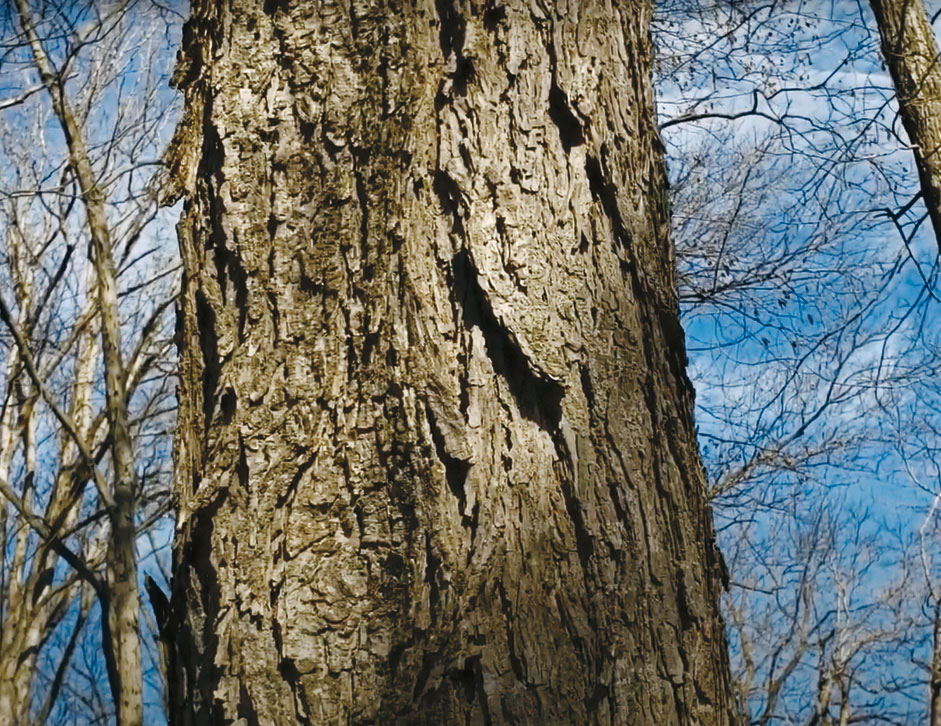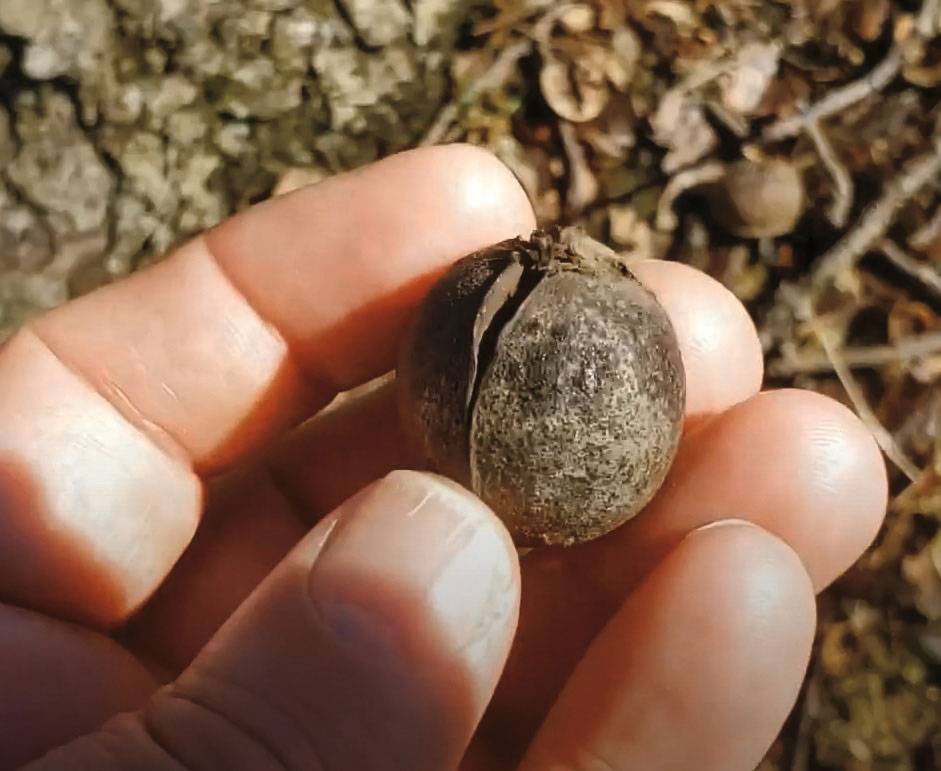Pignut Hickory
Indiana is home to many hickory species including pignut hickory. Pignut hickory, like all of our hickories, has alternate leaf arrangement, compound leaves, typically with five leaflets but sometimes with seven. The twigs tend to be smooth and dark brown in color and the end buds (terminal buds) oftentimes have an ice cream cone shape and will be covered with light tan to brown scales (Figure 1). Pignut hickory is typically found on upland sites with good soil moisture drainage. Oftentimes, pignuts will be associated with other species such as mockernut hickory, shagbark hickory and several of our upland oak species.  Figure 1
Figure 1
As we mentioned, typical leaves are five leaflet compound leaves, although occasionally we will find seven and sometimes they can be mixed on the same tree between five and seven. This is one of the good characteristics to help us with identification of pignut hickory compared to red hickory, which looks very similar in many instances. Red hickory typically has seven leaflets, but unfortunately sometimes five so that characteristic is not completely reliable. We’re oftentimes looking at the average leaflet count across the tree with pignut, typically five, and red, typically seven.
The bark on pignut hickory actually varies quite a bit in pattern. Typically, the bark will have long running ridges that are medium to dark gray in color (Figure 2). And sometimes we’ll see a little bit of plating and exfoliation on those ridges as well, suggesting to some extent shagbark hickory, but the plates typically aren’t nearly as broad or smooth and don’t exfoliate nearly as much as what we typically see on shagbark or shellbark for that matter. Figure 2
Figure 2
Another good identification characteristic for almost any of the hickories is looking at the shape of the nuts and the hull itself. A pignut hickory nut is very rounded with a very smooth actual hull on the outside edge of that nut. The husk on the nuts of pignut hickory can also be helpful to us. Think about pignut meaning partial, that is, the sutures on that husk itself only split part way down the sides of the nuts (Figure 3). This helps separate it from red hickory nuts that have sutures on that hull typically split all the way down to the base of the nut. So pignut hickory, one of our common upland hickory species easily confused with red and some other species, but take a look at that leaf count number on the compound leaves and the husk on the nut and that’ll help you with identification.
Wood characteristics vary greatly in hickory. The wood is nearly semi-ring porous, so the growth rings are usually somewhat subdued like walnut. Northern trees are usually very slow growth, and the rings are very tight. Southern trees may be somewhat faster growth. In true hickories the change from large to smaller pores is abrupt so these woods appear grainier as compared to the pecan hickories where the change is more gradual. Figure 3
Figure 3
Hickory has a wide variety of uses. It is poplar in the kitchen cabinet industry where it may be selected for all clear wood or with many of the small character marks left in the cuttings. It can also be selected for color as there is substantial contrast between the white sapwood and the brown heartwood. It is also used in flooring and furniture. Products made from hickory are often marketed as pecan regardless of the hickory species used. Because of the hardness, strength, toughness, and resiliency, hickory has had and continues to have many traditional uses. One traditional use is tool handles, such as sledge hammers, axes, picks, and hammers. Hickory is able to withstand the impact that occurs with these tools. It is prized for smoking meats, making skewers, and for using as fuel wood due to its high density.
Lenny Farlee is an extension forester with the Hardwood Tree Improvement and Regeneration Center at Purdue University. Prior to the HTIRC, Lenny worked with private landowners as a district forester for the Indiana Division of Forestry for more than 15 years. Dan Cassens is a professor emeritus of wood products at Purdue University. Dan and his wife Vicki own and operate Cassens Trees Christmas tree farm in West Lafayette, Indiana. More information about tree identification and hardwood lumber can be found online at https://www.purdue.edu/fnr/extension/.
